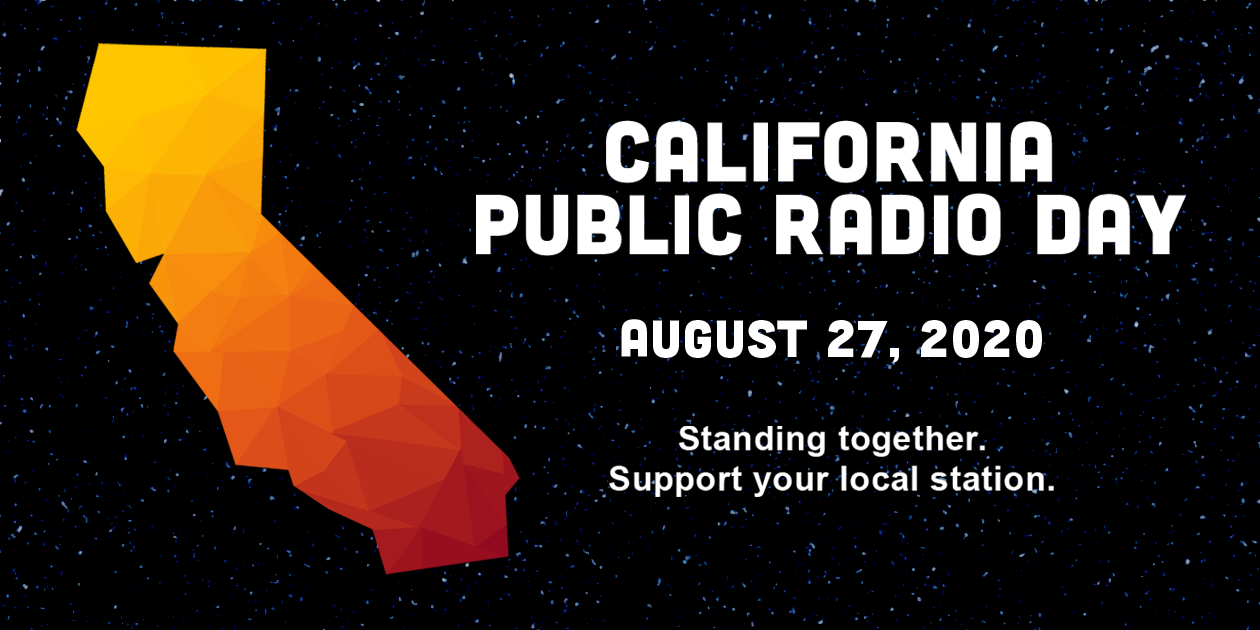
Every dog get his day. And with all respect to our canine friends, these “special days” can get hard to keep track of.
Last week, it was National Radio Day on August 20th, and many of you celebrated your alphabet soup of call letters that grace your resumes. It’s always fun to follow radio people on social media to remember who’s been where.
And today – August 27th – isn’t as impressive in scope. It’s National Pots De Creme Day (no clue) as well as National Just Because Day (seriously).
So, I was gratified to learn today is also the very first California Public Radio Day, a collaborative celebration among 13 public radio stations across the Golden State, representing metros that include L.A., San Francisco, San Diego, Bakersfield, and Long Beach.
This is an impressive initiative because especially here in the U.S., radio broadcasters don’t always play nice with their peers. Our futurologist friend, James Cridland, has implored us Americans in radio to “speak with one voice” – advice that has rarely been heeded.
And given the pressure and strain companies of all shapes and sizes are experiencing these days, it’s surprising there’s not more cooperation across companies and broadcast radio organizations.
That’s why this effort, spearheaded by KPCC in Los Angeles, is so impressive. First, California isn’t just another state in our union. If it was a country, its economy would rank fifth in the world – ahead of the UK, France, Italy, and Brazil.
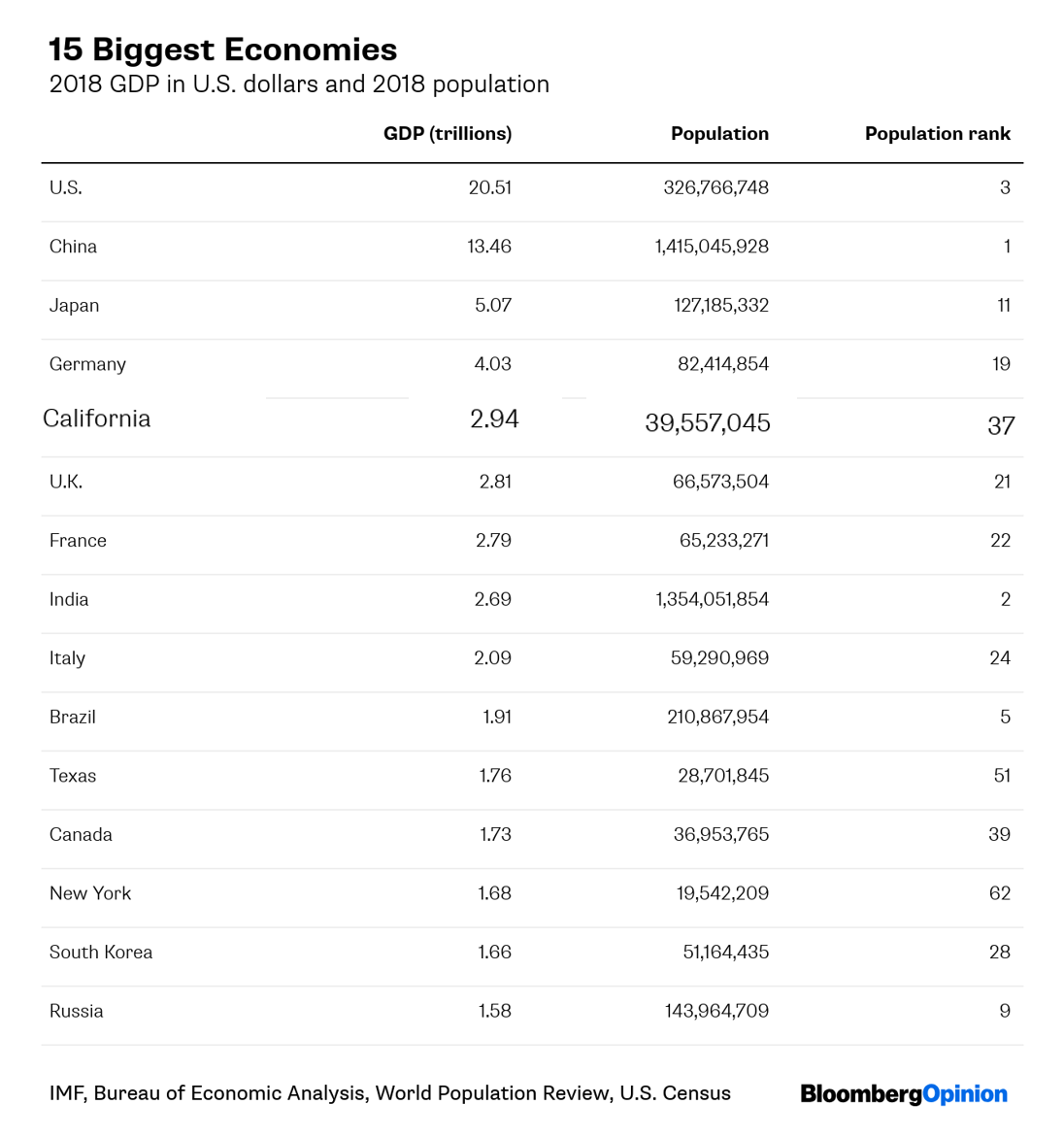
What happens in California matters, and that’s why this unique initiative is worth watching. In addition to drawing attention to public radio in general, the day-long fundraiser has lofty goals.
The hope is that by combining forces and using their respective “megaphones,” this impressive group of public radio stations can make a statement about the medium and its value.
This has been a crazy time for public radio, hitting the COVID crescendo this year. Most “NPR member stations” are committed full or part-time to local, national, and international news coverage.
Already this year, it’s been the impeachment hearings, the race for the Presidency, and then the unexpected – the pandemic and its vast ripple effects. Our research among public radio fans indicate the medium’s vital signs continue to be strong.
But that said, the erosion of “drive time” and “stay at home” orders has impacted ratings in many markets. Public radio has been especially prescient in preparing for the “digital revolution,” even leading the way in mobile apps, podcasts, and smart speaker access. But all of this comes at a cost, as audience lifestyles shift, roiled by COVID.
That has had an impact on public radio fundraising, especially important, of course, in the middle of the pandemic where businesses, foundations, sponsors, underwriters, and ordinary families are 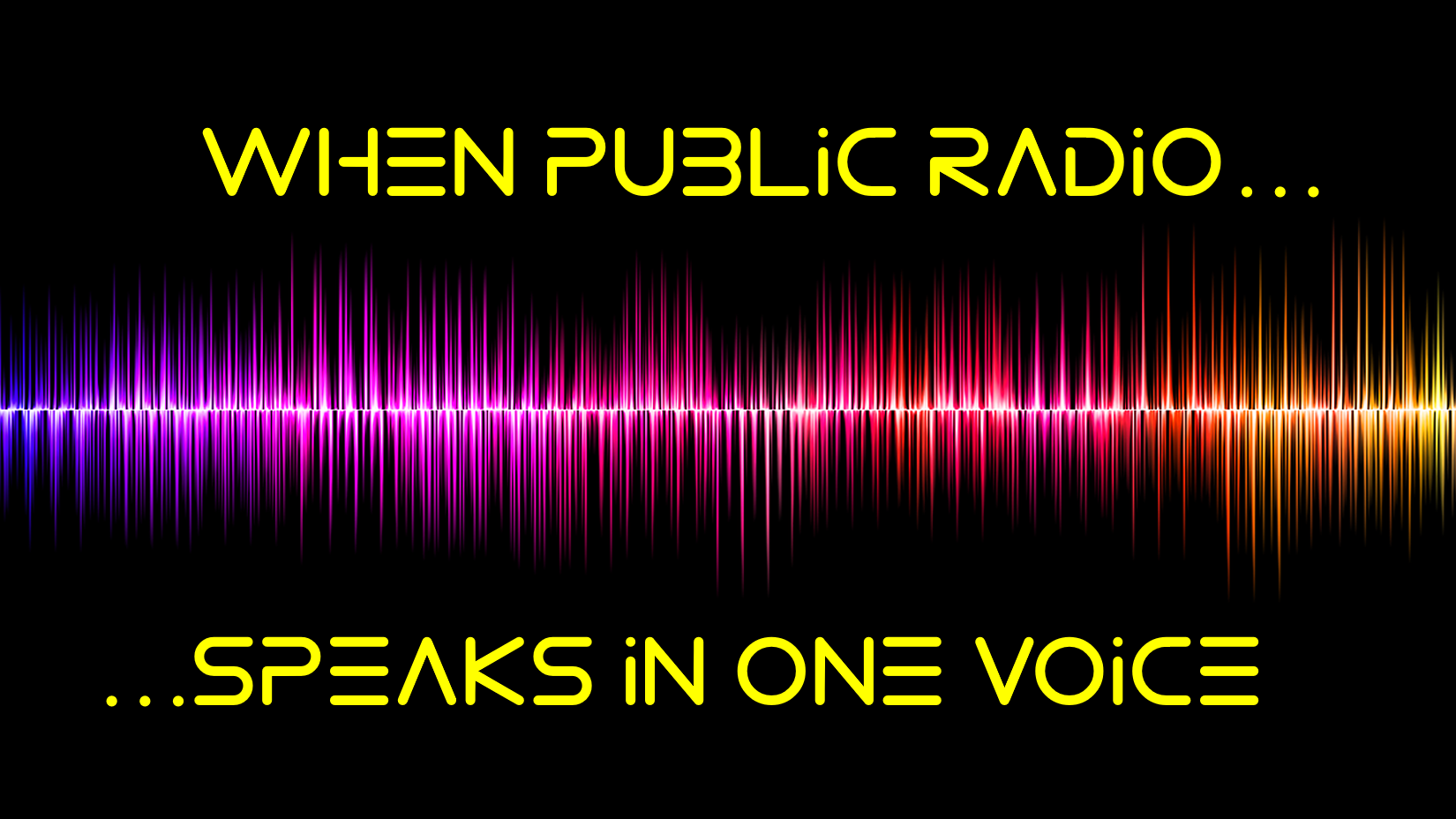 struggling to stay afloat. Discretionary dollars aren’t in great supply this year, and the immediate future is, at best, hazy.
struggling to stay afloat. Discretionary dollars aren’t in great supply this year, and the immediate future is, at best, hazy.
Despite beliefs to the contrary, the vast majority of funding for public radio stations comes from individuals, businesses, and foundations – not the federal government or from “our taxes.”
As tedious and interruptive as pledge drives can be, they are effective fundraisers for most public radio stations. Still, most of the brightest minds in public media are well aware the funding model has to change, adapt, or even be put out to pasture. Innovation is sorely needed.
This California Public Radio Day experiment is just a one-day effort – and it will be fascinating to see how well it connects with fans up and down the U.S.’s most populous state.
Our not-yet-released Public Radio Techsurvey 2020 took a look at fundraising during the pandemic. It’s the third of three studies we’ve conducted since COVID-19 became a force this past March.
Our key question revolves around whether public radio fans feel it is appropriate for stations to fundraise during this time. And as you can see by the trend (upper right), the audience has warmed to public radio’s need for support of their go-to stations:
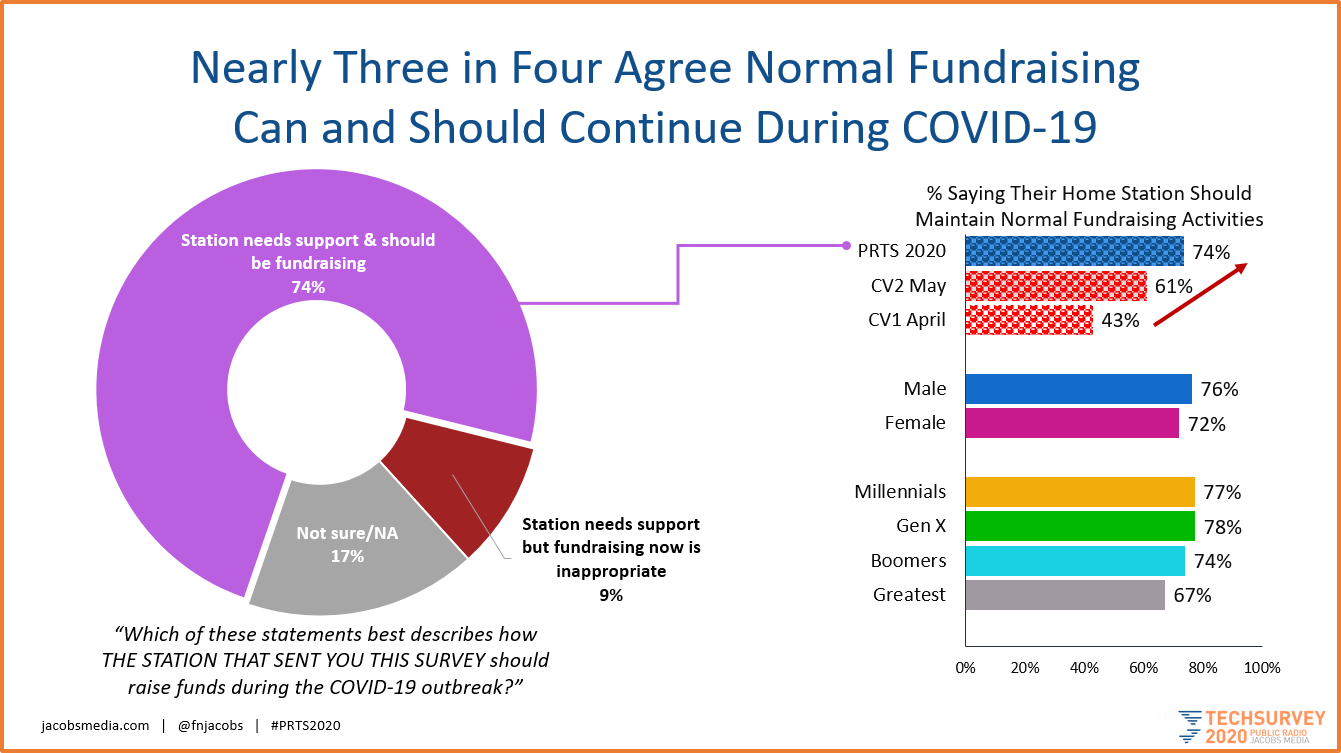
So, the audience is ready to contribute. And that’s good news for a broadcast radio platform dependent on its audience to pay for its content.
And as the Executive Director of the Public Radio Program Directors, Abby Goldstein, points out, this show of force is a positive:
“An effective partnership is one in which two or more organizations come together to accomplish something they would be unable to do separately. This collaboration is an excellent example of a partnership intended to raise the awareness of and support for the important role that public radio plays in the lives of the people of California. A single voice will only carry a short distance, but when many voices sing together, the music is loud and clear for everyone to hear.”
That should make 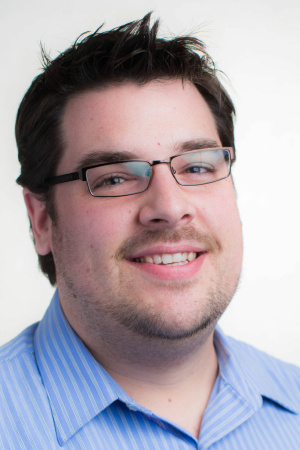 Rob Risko (pictured right) smile. He’s Director of Membership and Leadership Circle Giving for KPCC and LAist (a popular website that caters to all things Los Angeles). It turns out this special day should have happened this spring – until COVID took precedence:
Rob Risko (pictured right) smile. He’s Director of Membership and Leadership Circle Giving for KPCC and LAist (a popular website that caters to all things Los Angeles). It turns out this special day should have happened this spring – until COVID took precedence:
“We actually starting planning for the first California Public Radio Day back in December, and selected April for the day. But then the pandemic hit and we paused the initiative because we knew that breaking news was more important. As we’ve begun to establish this new routine, it felt appropriate to resurface the plans, so we selected this day in August.
“I think the day will be more impactful because of COVID, and I do believe the message of unity is heightened even further because of this new world we live in, but it would have happened regardless of the pandemic.”
And to everyone’s credit, public radio stations that are highly competitive the other 364 days a year – particularly KPCC in Pasadena and KCRW, a legendary station in Santa Monica – have put their dueling tote bags aside to work for their common good.
Today, they’re all on the same page, singing out of the same hymnal.
That’s something that all of radio could learn from. It’s common knowledge the medium has a heavy lift – when there’s not a pandemic.
Finding ways and projects where radio can come together – locally, regionally, and even nationally is in everyone’s best interest, especially at a time when the medium’s efficacy and value are being questioned.
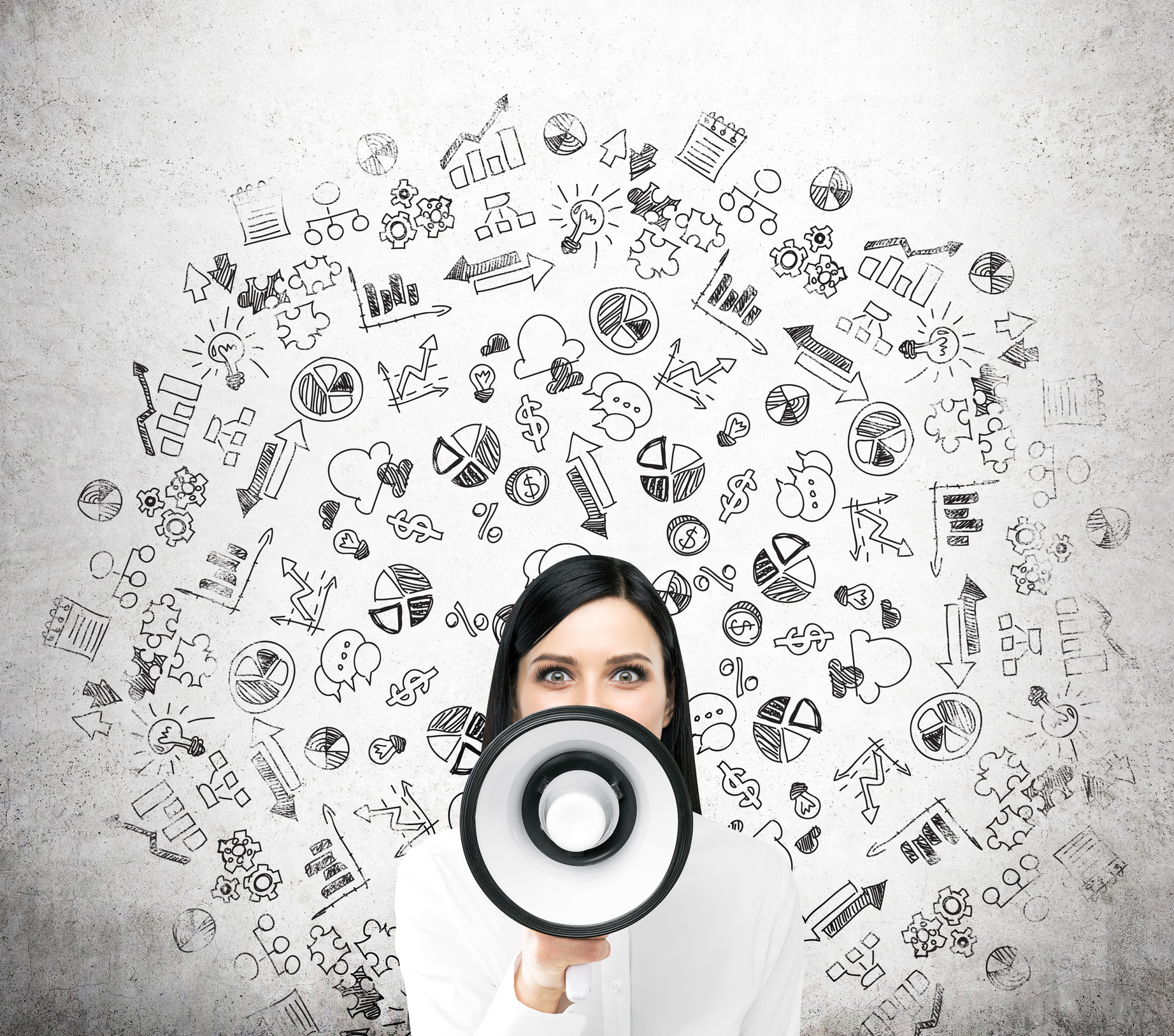 As we know from our festering political morass, speaking in one voice is easier said than done. It is becoming standard operating procedure to be antagonistic, tribal, and confident in the notion that “Our way is the best way.”
As we know from our festering political morass, speaking in one voice is easier said than done. It is becoming standard operating procedure to be antagonistic, tribal, and confident in the notion that “Our way is the best way.”
But in a year when spot revenue for commercial radio, and listener donations and sponsorship dollars in public radio are in short supply, playing the “zero sum game” is a fool’s mission.
Yes, all these stations are technically competing for the same pool of money – donations, membership, sponsorship, underwriting.
But today, their strength is in their numbers – finding a way to get past their proprietary differences for their common good.
Speaking in one voice requires compromise, flexibility, and even moments that are uncomfortable. But for the medium to get past this moment, it will require bold initiatives like this one.
Kudos to public radio’s many stations up and down the great state of California. We hope you have a strong day that’s an inspiration to others to try their own collaborations.
Participating stations in California Public Radio Day include:
KPCC (Pasadena)
KQED (San Francisco)
KCRW (Santa Monica)
KPBS (San Diego)
KAZU (Monterey Bay)
KZYX (Philo/Mendocino)
KRCB (Santa Rosa)
KCBX (San Luis Obispo)
KVPR (Fresno)
KCLU (Thousand Oaks)
88.5 (Northridge)
KPFK (Pacifica)
KKJZ (Long Beach)
- What To Do If Your Radio Station Goes Through A Midlife Crisis - April 25, 2025
- A 2020 Lesson?It Could All Be Gone In A Flash - April 24, 2025
- How AI Can Give Radio Personalities More…PERSONALITY - April 23, 2025




I agree, Fred, it’s great that they are banding together this way for the common good. (I would have liked to see a list of the participating stations.)
It is puzzling that public radio has not explored a potential tool that IBOC digital broadcasting could make available to them that I think would boost support/revenue: conditional access. For example, while their main analog signal would of course be simulcast and synchronised on their HD1 signal, they could have say an HD3 signal available only to subscribers that would carry the uninterrupted public information programming for which the stations are famous. Those listeners who, like me, always subscribe wouldn’t have to grit our teeth through the pledge breaks (or look for the stream of another station elsewhere in the country that isn’t pledging this week). I’d buy the necessary receiver in a heartbeat.
Interesting thought, John. Several have a “pledge-free stream” you can access with PIN after you donate. So I’m not sure how you’d password protect an HD3. Or am I missing something?
Conditional access was talked about a few years ago in the trade papers. It would require a way for the listener to log in using an HD Radio receiver with that capability, which of course is none of them at this time. I don’t know how difficult it would be to add this functionality, but if the public radio broadcasters united behind the idea I think we would hear some answers. Surely they have nothing to lose and much to gain.
That is true. Thanks, John.
On “speaking in one voice” I’ve wished many times there was an American equivalent to the UK’s Radiocentre. They’re doing some excellent work to tell the story of radio and its successes even in challenging times. I’d like to see US broadcasters develop some of the same unity and messaging.
Not to mention Radioplayer! Thanks, Matt.
Hi Fred – here are the stations participating in #CaliforniaPublicRadioDay:
@903KAZU
@kcrw
@KQED
@KZYXFM
@KPBS
@KPFK
@KCLUlive
@KPCC
@885fmsocal
@KALW
@EmpireKVCR
@KVPR
@KCBXFM
@KJAZZ881
@kzsc
FYI
Oh, and us @krcbfmradio91
Thanks, Sean. I will add the list to the post. Even KRCB! Thanks.
I know this isn’t the point of your blog post today, but I am disappointed that you have no clue about Pots De Creme, Fred. It is a really amazing dessert, and I think you need to track one down soon. 🙂
You know, Amy, I Googled it & it just didn’t look familiar. Creme brulet, yes. Where do I gets Pots De Creme?
Fred, normally I’d suggest several restaurants in Detroit…but since the food industry has been hit so hard in 2020, it’s difficult to know who is actually serving it (and which restaurant is serving a really good one at that!). I’ll send you an email offline with my mom’s recipe: yep, that’s right, you’re getting a family recipe. It’s a small token of my appreciation for your insights.
Sweet of you, Amy. (Pun intended!). Thanks.
I believe KQED has experimented with a “non pledge” stream a few years back. I don’t want to speak for them. As we’ve studied that at MPR and SCPR, we noted that you almost have to do double on-air staffing. That is, do you move your key morning anchor to the pledge free stream, and lose your best spokesperson? Or do you keep that person on the drive stream, and have subs on the pledge free? Or do you solder the switch to network on the pledge free? (We already run BBC news 24/7 on our HD2 stream at KNOW in Mps.) There are a host of intricacies to cracking that code. Yet…still worth exploring. Thanks for lifting up the California example. I believe our industry will be collaborating, partnering, more and more.
Appreciate the comment, Tim, and you reading our blog. I think those pledge-free streams sound good to listeners on paper. It’s another whole thing when those who listen a lot on “regular radios” have to remember to access the stream. A lot to think about. And yes, an impressive job by these California public radio stations.